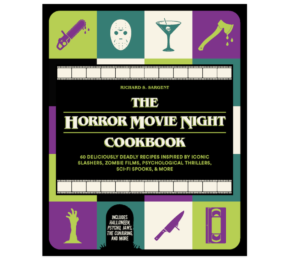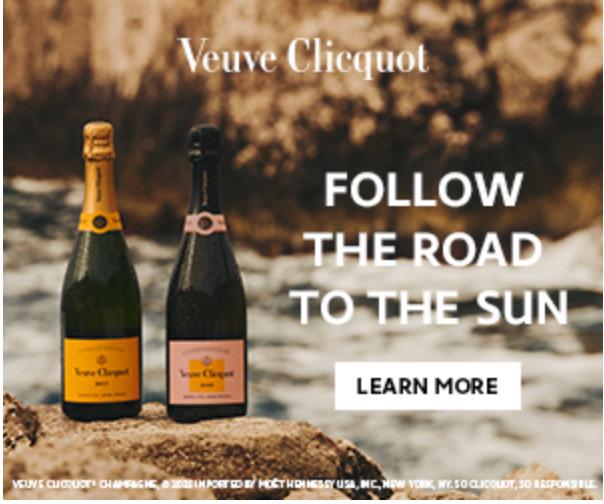Philly Foodies! Invite your friends over for a delicious dinner with Horror Movie Night Cookbook written by Richard S. Sargent and Nevyana Dimitrova (Photographer).
Sixty deliciously deadly recipes inspired by iconic slashers, zombie films, psychological thrillers, sci fi spooks, and more.

Horror Movie Night Cookbook can be found at any local bookstore or online Barnes Noble, Amazon. Follow the Horror Movie Night Cookbook Instagram.

Author Richard S. Sargent joined me for a conversation about food, cooking, horror movies and Halloween. The below conversation has been edited for length and clarity. Find the full, un-edited conversation at our YouTube channel.
What inspired you as far as horror movies go? What’s your all time favorite horror?
Richard Sargent: Wow, that’s a tough one. Yeah, so I would say my all time favorite horror movie is Scream. It’s what got me into diving deeper into horror. My mother actually got me into horror when I was a kid, we would watch a bunch of the old ones after school and that sort of thing, but as I started to discover the newer ones on my own, Scream was the first one that really showed me that there’s more to horror than just blood and boobs.
You’re a filmmaker, an artist, an author, many things. Tell us a little bit about your journey
Richard Sargent: I went to school for theater and film and acting. As most people do New York or LA, I chose New York. I did that for a while. I did a couple of my own indie horror films as well. And then as I was trying to figure out what I wanted to do.
As a side project, because you have to have a side project when you’re trying to break into that field. I thought I love cooking. I love experimenting. I love being creative. Let’s take some culinary classes. So I was gifted some culinary classes and it was really great. And I thought, okay, great. Now I’m going to go work in a kitchen. But the more I thought about that, I realized I would hate it if I had to do it as a day job. I would hate cooking. I put that on the back burner and focus more on the theater and film and all that.
And just kept plugging away at that. When I moved to the West Coast, I became artistic director of a couple of theater companies and had some plays published, that sort of thing.
So my writing and my directing was starting to take off a little bit. I had a little more free time to go back to the cooking thing that I was looking forward to doing. And the way this came together is that I was doing a play with some friends and we were chatting we actually were doing the play, The Woman in Black, and we were chatting about horror and horror films and they felt the way I felt about them initially, that they’re all just and I just couldn’t have that.
I’d seen so many great ones that have changed my life and had so many positive messages. Because horror movies are basically about the outcasts winning. I felt like I’ve been an outcast my whole life, so I could really connect to them. So I started showing them the ones that I thought were important.
I started with my favorites and then dug deeper into the ones that I felt. Told really great stories and had really great messages through these horror movie nights where I would pair an appetizer, a dinner and a dessert, each with its own movie and we would do three movies a night and we would do this every couple of weeks.
Can you talk a little bit about this book’s undertaking and 1-2 lessons that you learned from that process?
Richard Sargent: Absolutely. Yeah, it really was an undertaking. When I started these nights, these horror movie nights myself I just thought they were going to be fun. I just thought we were all going to have a good time.
Then about halfway through, maybe about five or six nights in, my friends were all like, what are you going to do with this? I’m like, what do you mean? We’re just having a good time. And they’re like, no, other people are going to want to do this. I’m thinking about what can I do with this?
Maybe I can start an event service and cater these nights myself? But ultimately I chose to do a book because it’s more accessible and it’s more fun. You get to do it in your own home and invite your friends over and it makes for a much more fun evening. Once I decided that it was going to be a book, it took about two years to compile it all into book format. Retake some pictures, that sort of thing, get it all ready for my copy. So I self published it two years ago and then it got picked up.
So the version that you have and that we’re talking about today is the version that Ulysses Press put out about another year or so later.
So it was about a five year process from the first horror movie night, all the way to the book that, that we’re talking about today.
If I have any tips for people, find what makes your idea stick out. What about your idea do people want to know, be authentic about it and just keep plugging away at it.
You’re going to get frustrated. Move on to another project, take a walk, do something else. And come back when the inspiration strikes, but never force anything. That’s my big thing. You can’t force inspiration or you’re not going to end up with the best product that you could possibly have.
From the five years ago first draft to Ulysses Press version now, how close is the finished product compared to your original vision?
Richard Sargent: It’s very close actually. A lot of things that were changed were just improvements on the pictures. Things are worded differently, more clear, more consistency throughout the book.
Ulysses was really great with the editing process. They kept a lot of what I wanted to do with the book and the whole spirit of the book.
There’s millions of horror movies out there. How did you go from a million down to 60?
Richard Sargent: It really had to just speak to me. It had to be bigger and better than the average horror film. Or at least I had to view it that way.
I studied horror and I studied film throughout my life. I can grasp the difference between your average horror film and something that’s trying to influence the viewer in some way. And those are the ones that I tried to put into the book. I know that 60 is not a lot and that’s why there will be more books hopefully.
I thought it would be a fun start to break newbies in. So rather than just hitting every classic that you can think of: Exorcist, Jaws, I picked a lot of classics and mixed them in with some newer things that had more up to date themes and up to date comments on society, like The Conjuring and The Descent, movies like that.
Not everyone seeing this is a huge horror movie fan. Can you give us any tips or ideas about what makes a really great horror movie?
Richard Sargent: I think it all starts with the characters which then reflects on the script. So if it’s a really well written script, it has characters that A) you care about and B) are telling a story within a story, basically, by living through their story, they’re telling us how we should be living our lives. Of course, we know that because of Scream and movies like that, we know the rules of horror.
Don’t don’t say “I’ll be right back” and all that kind of stuff.
But beyond that, there are things that make a horror film great. It’s a lot of really great being on the side of the outcasts. So if you think of movies like Frankenstein a lot of people will say that the monster is the monster, but the monster is not the monster. The society not accepting the monster Is the real monster.
That’s a film that tries to show us how to accept people who are not like us. Some people may say that science is the monster. I am not that kind of person. But, there’s the commentary in that film too, that maybe we shouldn’t do everything that we are able to do with science.
For queer culture and women’s rights we have films like Hereditary that dive into dealing with grief.
As long as your characters are doing something important, they’re not just playing with a Ouija board, or running into a shed full of chainsaws. As long as they’re making smart decisions,, I think it elevates it to the next level, movies like The Exorcist, obviously, more recently, I thought Barbarian just from last year was outstanding, just in that way of telling the story, that was creative to me.
Ones that stick with you forever. Jaws, a lot of people didn’t want to go in the water after that.
We have a very dinner party kind of an audience. Do you have a favorite kitchen gadget?
Richard Sargent: Yeah, so I had to cook these meals. There were actually some other recipes that I worked on too, for these films that I didn’t put in the book. Everything is trial and error in the kitchen. So I cooked several of these many times until I found the right measurements of everything.
It was a long process in the kitchen, but a fun one, of course.
Maybe it makes me basic, but my favorite kitchen gadget is the slow cooker because you can do so much with it and you can step away from it and work on other things while your main meal is sitting there for hours.
Are there 1-2 recipes in the cookbook that you want to point out?
Richard Sargent: As I like to start any meal, let’s start with dessert. I would say I’m super proud of the pavlova from Cabin Fever, if you’re familiar with the movie. The dish is called The Close Shave, and it is a pavlova with Chantilly cream inside and berries on top, berry compote on top, and it just drips through a bloody wound.
I’m pretty proud of that one, and I got a lot of great feedback. I still have my friends from that horror movie night talking about it all the time.
Another one I’m super proud of is the paella from Broken Lizard’s Club Dread, which is an overlooked horror comedy. Basically, Coconut Pete runs this party island and he has his own special paella, Coconut Pete’s paella, which I tried to recreate with his secret ingredients and I thought it came out pretty well, so I’m pretty pleased with that one as well.
Let me see, appetizers. One that was fun was just coming up with the popcorn for Scream. I tried a bunch of different flavors and a bunch of different ways of doing it and it’s one of the ones that I feel is a recipe, but also a hack. An easy way to pop bagged popcorn and put flavoring on it.
It’s a good one to show that anybody can do what’s in this book. You don’t have to be Martha Stewart to be able to create what’s in this book, recreate it.
When the book first arrived, I was sitting in a room with teenagers and as old as people in their 70s, so it’s quite a range and we were all having fun with it.
As an author, as a creator, how does that make you feel? Was it designed to be a communal experience?
Richard Sargent: Putting things out there always makes me nervous. The feedback that I’ve been getting, hearing people, seeing pictures from people doing their own horror movie nights or just recreating the recipes or just on podcasts and things talking about the clever titles and all that kind of stuff it just makes me feel so good because I was worried that maybe this is just a “me” thing, like I’m just this weirdo super into horror and food. It’s good to know that I’m not. The whole horror community, the whole film community is into something like this.
They they can entertain, they can bring their own friends over. They can be the star of their own show. It speaks to everybody.
Since you are the Horror Movie Night Cookbook expert, can you give us some tips and advice for our next movie night?
Richard Sargent: I’ve done horror film nights where we just all get together and we eat the food and we watch the movies.
I’ve done one’s where we play extra games other than the drinking games. We have costume contests. It’s really how far you want to go into it.
But I would say start early if you’re going to use some of the recipes in this book, start early because there are many things that could go wrong especially if you’re not used to cooking and there are things that could go wrong, things that could burn things that might not set the way you want them to.
Have extra ingredients on hand.
If you don’t like a movie that the recipe is paired with, think about how that recipe could go with another more you like more?
Have fun with it and try it all.
How can we elevate the experience to a Superbowl Sunday level?
Richard Sargent: Definitely add costumes. Decorate. Fog machines are always fun. Pick the ones that pick the recipes that can make it a more social evening. Maybe ones where you add your own stuff to them. Like the one for Cujo is like a burrito bowl, essentially, so that people can add their own ingredients to it. That gets people up and mingling and having a good time, definitely play the drinking games, but be careful because the drinks are strong.
It’s Halloween season right now. When is the best time of year for the Horror Movie Night Cookbook?
Richard Sargent: All year. There’s no set time. Horror has so many stories to tell. A lot of them are very important that you can watch them all year round.
Get in that spirit all year round. I think that people don’t give horror the credit that it deserves. There are a lot of great films out there that even people that don’t love horror will like. Those are the ones I think we should be talking about. Horror should always be part of the conversation.
A lot of horror films are set throughout the year, so if you wanted to do a horror movie night for Valentine’s Day, you’ve got plenty to choose from, It’s not just for those of us that like to get dressed up one day a year. It’s all year round.
As we wrap up, any final message you want foodies or movie lovers to know about you or this book?
Richard Sargent: I would just want them to know that I really did put a lot of thought and heart into everything that they see in this book. I really didn’t just say, Oh, wow, let’s come up with some gimmicky-looking cookie or something. These aren’t decorations. This is real food and real thoughtful recipes that are inspired by things that happen in the film, things that they eat, things that they do, places they go. For example, in The Descent, they are supposed to be spelunking in the Appalachian mountains. So I used a local dish from the Appalachias as that recipe. These are not just Halloween decorations. These are actual recipes that you can enjoy any time of year. But watch the movie too. So yeah, I would just want people to know that don’t expect cutesy little Pinterest ghost cookies. That’s not what you’re going to get. You’re going to get real recipes like you would in any cookbook. This just has the horror edge to it as well.
Where can we learn more about you? Tell us the website, the social media
Richard Sargent: The book can be found at any local bookstore or online Barnes Noble, Amazon.
If you want to learn more about me, or just maybe get bonus recipes every now and then on my Instagram you can follow the Horror Movie Night Cookbook Instagram, or my own personal one, @rsargent83.
Tell me what you like. And if you host your own, tag me in that sort of stuff. I’d love to see how your recipes come out, what you would change. I’d love feedback. If you do try any of this, please contact me online and let me know what you liked and what you didn’t.



